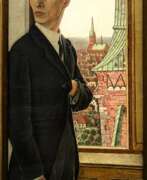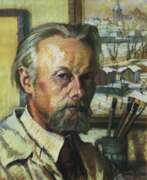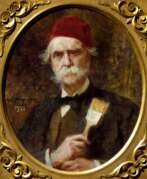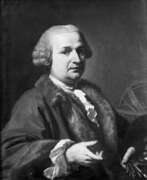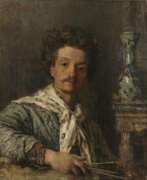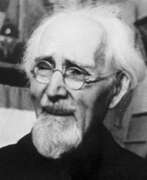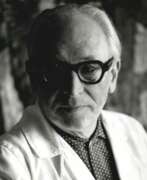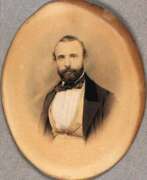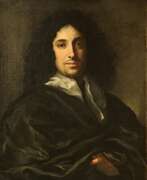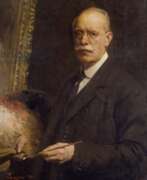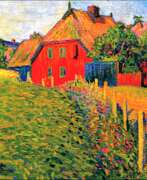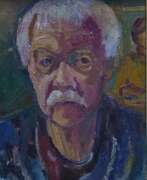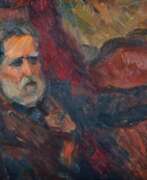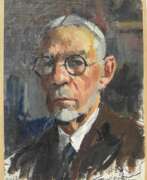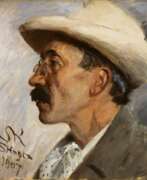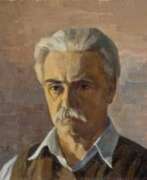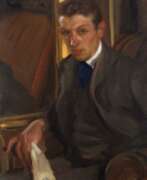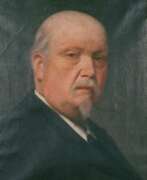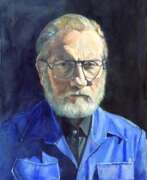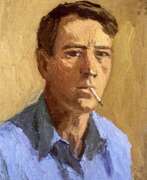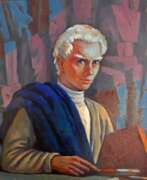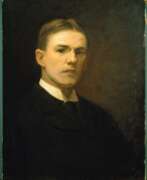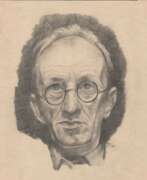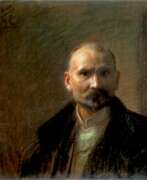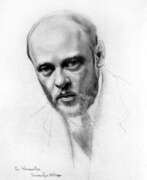Educators Self-portrait
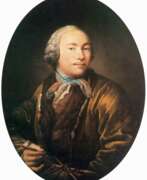

Ivan Petrovich Argunov (Russian: Иван Петрович Аргунов) was a distinguished Russian painter of the 18th century, celebrated for his significant contribution to portrait art. As a serf born into the Argunov family, who were established artists themselves, Ivan's talent was nurtured and supported by his patrons, leading to a unique position within the cultural and artistic hierarchies of his time. His specialization in portraiture allowed him to capture the essence of Russia's social elites, including members of the imperial family, as well as ordinary Russians, thereby providing a wide-ranging visual documentation of the era's societal strata.
Argunov's art is noted for its meticulous attention to detail, vibrant realism, and the emotional depth he brought to his subjects. His portraits are more than mere representations; they are intimate glimpses into the lives and characters of his sitters. Among his most famous works is the portrait of Princess Natalia Petrovna Golitsyna, showcased in the Tretyakov Gallery in Moscow. This particular piece stands out for its intricate portrayal of fabric textures and the detailed rendering of facial expressions, which have been lauded for their lifelike quality and depth.
Argunov's legacy extends beyond his artistic achievements; he played a pivotal role in shaping the course of Russian portraiture. His works are preserved in major museums and galleries across Russia, serving as a testament to his skill and the cultural richness of his time. For collectors and experts in art and antiques, Argunov's paintings are not just historical artifacts but are cherished for their aesthetic value and the insight they offer into 18th-century Russian culture.
We invite enthusiasts and collectors to stay connected with us for updates on new product sales and auction events related to Ivan Petrovich Argunov. By signing up, you will gain exclusive access to the finest pieces of Russian art and antiques, ensuring you never miss an opportunity to enrich your collection with works by one of Russia's most esteemed artists.
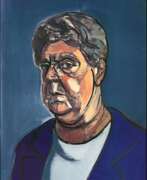

Leland Bell, an American painter born in 1922 and passed away in 1991, is a figure whose artistic journey and output stand as a beacon of individuality and depth in the 20th-century art world. Bell's dedication to painting was profound, shaping a career that remained largely self-taught yet significantly influential. His work, characterized by a passionate engagement with both abstract and figurative painting, represents a unique blend that defied the dominant trends of his time, making him a crucial figure for collectors and art enthusiasts.
Bell's artistic signature is evident in his choice of subjects—still life, portraiture, and figure composition—handled with a distinctive blend of abstract principles and figurative clarity. His paintings are recognized for their bold contour lines, vibrant planes of color, and dynamic compositions, revealing a singular vision that bridges the abstract with the tangible. This approach allowed him to explore the depth of human and thematic elements with an intensity and psychological complexity, particularly seen in his self-portraits and family group scenes, which often carry a mythic quality, elevating everyday existence to the level of allegory.
Significant in Bell’s legacy is his ability to convey the essence of his subjects with a sculptural weight, granting them a presence that is both immediate and timeless. His paintings, such as the "Family Group with Butterfly" (1986-90) and his series of self-portraits, demonstrate a mastery of form and space that invites viewers into a deeply personal yet universally resonant world. Bell's influence extended beyond his canvas through his roles as a teacher and lecturer, where he passionately advocated for the artists he revered, contributing to a rich educational legacy that complemented his artistic achievements.
Bell's works are held in prestigious collections and have been the subject of retrospective exhibitions, such as at the Phillips Collection in Washington, DC, highlighting his enduring impact on American art. His dedication to exploring the nuances of form, color, and composition has left a lasting mark, ensuring his place among the notable artists of his generation.
For collectors and experts in the field of art and antiques, Leland Bell's oeuvre offers a compelling study in the power of painting to convey complex human emotions and narratives. His work remains a testament to the enduring relevance of figurative art in the modern era, and his contributions continue to inspire new generations of artists and collectors alike.
To stay informed about new discoveries, sales, and auction events related to Leland Bell's work, signing up for updates is a practical way to ensure you don't miss out on opportunities to engage with the legacy of this remarkable artist. This subscription is a business-like avenue to keep abreast of events that celebrate Bell’s artistic achievements and offer insights into his profound impact on the art world.
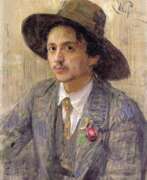

Isaak Israelievich Brodsky (Russian: Исаак Израилевич Бродский), a distinguished Russian artist, was renowned for his contributions to painting and teaching. Born in Sofievka, Russian Empire, Brodsky's artistic journey led him to become a pivotal figure in the Soviet art scene, primarily recognized for his realistic portraits and social realist works. His dedication to capturing the essence of his subjects, combined with a unique sensitivity to color and form, allowed his art to transcend mere representation, offering insights into the culture and political climate of his time.
Throughout his career, Brodsky was closely associated with significant cultural and political developments in Soviet Russia, becoming an official artist of the Soviet regime. His works, such as the iconic portraits of Lenin and other political figures, not only exemplify his skill but also serve as historical documents, offering a glimpse into the era's social fabric. His commitment to realism and the portrayal of Soviet ideals earned him a prominent place in the art world, influencing generations of artists through his role as a teacher and mentor at the Repin Institute of Arts.
Brodsky's legacy is preserved in numerous museums and galleries, with his masterpieces forming an integral part of Russia's cultural heritage. His ability to intertwine art with historical narrative has made his work a subject of study for art collectors and experts alike. For those intrigued by the depth and historical significance of Soviet art, Brodsky's oeuvre offers a fascinating exploration into the power of visual storytelling.
For collectors and experts keen on delving deeper into the rich tapestry of Russian art, staying informed about Isaac Israelievich Brodsky's work is essential. Signing up for updates ensures exclusive access to news on product sales and auction events dedicated to Brodsky's art, providing a unique opportunity to engage with the history and culture he so vividly depicted. Join us in celebrating the legacy of a true maestro of painting, whose works continue to inspire and captivate audiences worldwide.
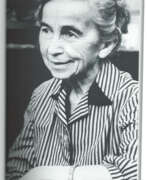

Varvara Dmitrievna Bubnova (Russian: Варвара Дмитриевна Бубнова) was a distinguished Russian painter, graphic artist, and pedagogue, celebrated for her mastery in lithography. Born into a noble family in St. Petersburg, she was deeply immersed in an atmosphere of poetry and music from an early age, which significantly influenced her artistic and intellectual development. Bubnova's education spanned from the Drawing School of the Society for the Encouragement of Arts to the St. Petersburg Academy of Arts, where she was an active member of the avant-garde group "Union of Youth" alongside prominent figures like Mayakovsky, Malevich, and Goncharova.
Her journey took a dramatic turn in 1923 when she moved to Japan, marking the beginning of a transformative period where she not only embraced Japanese art forms like suibokuga and Sumi-E ink drawing techniques but also significantly contributed to Japanese cultural life through her work and teachings. Her unique approach to art and education left a lasting impact on Japanese arts and culture. Among her notable works inspired by her experiences in Japan are "Young Violinist" (1942) and "Village Street. Japan" (1953), showcasing her fascination with Japanese life and aesthetics.
The later years of her life were spent in Sukhum, Abkhazia, where she continued to create vibrant and expressive works, demonstrating a remarkable adaptability and evolution of her artistic style throughout her life. Her works from this period, such as "Behind the Green Door" (1972), highlight her ongoing exploration of color and form. Bubnova's legacy extends beyond her artworks, as she played a crucial role in promoting Russian literature in Japan, contributing to a deeper understanding and appreciation of Russian culture among Japanese audiences.
Bubnova's artworks are part of major collections domestically and internationally, showcasing her diverse talent across various mediums and subjects. Her influence on both Russian and Japanese art scenes underscores her position as a bridge between cultures, celebrated for her artistic innovations and cross-cultural contributions.
For collectors and experts in art and antiques, Varvara Dmitrievna Bubnova's works represent a unique fusion of Russian avant-garde principles with Japanese artistic traditions, making her a fascinating figure whose pieces are a testament to a life spent transcending cultural boundaries. To stay updated on new sales and auction events related to Varvara Dmitrievna Bubnova's works, sign up for updates and immerse yourself in the legacy of this extraordinary artist who effortlessly blended the best of two worlds.
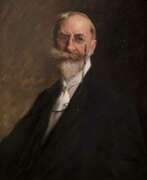

William Merritt Chase was an American painter, celebrated for his role in establishing Impressionism in America and his profound influence as an art educator. Born on November 1, 1849, in Indiana, Chase became a pivotal figure in American art, blending Impressionist and Realist styles with a distinctive flair that captured both cityscapes and intimate studio settings. His mastery of oil, pastel, and watercolor allowed him to create works renowned for their vibrancy and expressiveness.
Chase's career was notably marked by his transformation of studio environments into aesthetic showplaces, making them centers of social gatherings that enhanced his stature in the art community. His tenure at the Shinnecock Hills Summer School and his travels in Europe, especially his interactions with European artists, were crucial in shaping his artistic direction. Notably, his exposure to French Impressionism through exhibitions in New York profoundly influenced his style, integrating lighter palettes and freer brushwork which became evident in his landscapes and portraits.
Chase's works are celebrated for their innovative use of color and composition, qualities that made him a leading figure in American Impressionism. His notable works include scenes of everyday leisure, portraits, and vibrant landscapes, capturing the essence of his era with elegance and sophistication.
If you are intrigued by the artistic journey and impact of William Merritt Chase, consider signing up for updates. This subscription will keep you informed about new sales, upcoming auctions, and events related to his works. Stay connected with the vibrant world of William Merritt Chase and enhance your collection with knowledge and opportunities. Sign up today!


Ulrich Hachulla is a German painter and graphic artist, representative of the New Objectivity movement, who lives and works in Leipzig.
He was educated at the Academy of Fine Arts in Leipzig and, in addition to painting, has mastered many graphic techniques.
Hahulla's portraits and self-portraits depict a man in solitude, unsociable, coldly detached - these are numerous types of the respective times. The artist also creates paintings with mythological and allegorical references.


Hans Hofmann, a German-American painter, stands as a towering figure in the 20th-century art world, celebrated for his vibrant contributions to abstract expressionism. Born in Germany in 1880, Hofmann's journey in art took him across continents, from Europe to the United States, where his innovative teaching methods and bold, color-filled canvases left an indelible mark on generations of artists. His unique approach to painting, characterized by a dynamic interplay of color and form, helped bridge the gap between the European modernist traditions and the emerging American abstract art scene.
Hofmann's work is distinguished by its intense color palettes and the technique he termed "push and pull," which refers to the careful balance of color and shape to create depth and movement within the canvas. This technique not only showcased his mastery over the medium but also influenced the development of abstract expressionism, making Hofmann a pivotal figure among his contemporaries. His paintings, such as "The Gate" (1959-60), exemplify this approach and are celebrated in prestigious museums worldwide, including the Museum of Modern Art in New York and the San Francisco Museum of Modern Art.
Beyond his personal contributions as an artist, Hofmann was an esteemed educator, guiding the next generation of artists through his schools in New York and Provincetown. His teaching philosophy emphasized the importance of understanding the fundamental elements of art—color, form, and space—and their interrelation, which he believed was key to achieving harmony and expression in painting.
For collectors and experts in art and antiques, Hans Hofmann's works represent not just significant artistic achievements but also valuable pieces of cultural history. His paintings and teachings continue to inspire and influence the art world, making his pieces highly sought after in galleries and auctions.
We invite you to sign up for updates on new product sales and auction events related to Hans Hofmann. This subscription is your gateway to owning a piece of art history, ensuring you're informed of the latest opportunities to add to your collection. Join us in celebrating the legacy of a master whose work transcends time and continues to dazzle the art world.
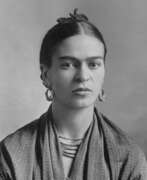

Frida Kahlo de Rivera was a Mexican painter, renowned for her captivating self-portraits that blend realism and fantasy. Born Magdalena Carmen Frida Kahlo y Calderón on July 6, 1907, in Coyoacán, Mexico City, she is celebrated for her profound exploration of identity, postcolonialism, gender, and class within Mexican society. Kahlo's works are a fusion of naïve folk art style and surreal elements, deeply influenced by Mexican popular culture and her personal experiences of chronic pain and disability.
Despite facing numerous challenges, including polio in her childhood and a catastrophic bus accident at 18, Kahlo's resilience and passion for art were undeterred. Her marriage to the famous Mexican artist Diego Rivera was both a romantic and artistic alliance. Kahlo's paintings, such as "The Two Fridas" (1939) and "Self-Portrait with Thorn Necklace and Hummingbird" (1940), are not only masterpieces of visual art but also compelling narratives of her life's trials and triumphs.
Kahlo's artistry extended beyond the canvas, as she was actively involved in the Mexican Communist Party, and her home, La Casa Azul, is now the Frida Kahlo Museum, a place of homage for her admirers. Although her work was not as widely recognized during her lifetime, Kahlo's legacy has grown tremendously, making her an icon for various social movements and a beacon in the art world.
For collectors and art experts, the journey into Kahlo's world is both a dive into Mexican cultural heritage and an exploration of the profound human experience. If you're passionate about Frida Kahlo's work and want to stay informed about related product sales and auction events, sign up for our updates. This is not just a subscription; it's an invitation to celebrate and own a piece of art history.
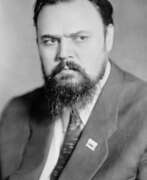

Aleksandr Ivanovich Laktionov (Russian: Александр Иванович Лактионов) was a distinguished Russian artist, celebrated for his intricate approach to painting and his ability to capture the essence of Soviet life through his art. Born in 1910, Laktionov's work spans a crucial period in Russian history, reflecting the cultural and social transformations of his time. He is renowned for his hyperrealistic paintings, which stand as a vivid chronicle of the era's ethos and its people's spirit.
Laktionov's artistry is marked by his meticulous attention to detail, a characteristic that has endeared him to art collectors and experts alike. His paintings are not just visual masterpieces; they are historical documents that offer a window into the daily lives of Soviet citizens, making him a vital figure in the study of Russian culture and art history. Among his most celebrated works is "A Letter from the Front," housed in the Tretyakov Gallery, Moscow. This painting is emblematic of Laktionov's ability to merge technical precision with deep emotional resonance, capturing the poignant realities of wartime Russia.
For collectors and experts in art and antiques, Laktionov's oeuvre represents an invaluable insight into the Soviet aesthetic and its underlying ideologies. His works are a testament to the enduring power of art to reflect and shape the narrative of its time. As interest in 20th-century Russian art continues to grow, Laktionov's paintings remain highly sought after, not only for their artistic merit but also for their historical significance.
We invite collectors and enthusiasts to sign up for updates related to Alexander Ivanovich Laktionov. Subscribing will keep you informed about new product sales and auction events featuring Laktionov's work. Rest assured, this subscription is focused solely on providing you with the latest opportunities to enhance your collection with pieces from one of Russia's most revered artists.
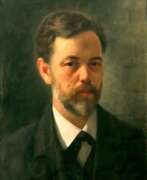

Andronik Grigorievich Lazarchuk (Russian: Андроник Григорьевич Лазарчук) was a Ukrainian and Soviet artist, born on January 15, 1870, in Ukhovetsk, Volhynian Governorate, and passed away on September 6, 1934, in Borzna, Chernihiv region. Known for his contributions to painting, teaching, and cultural activities, Lazarchuk's work primarily featured portraits, everyday scenes, and landscapes.
Lazarchuk began his artistic journey studying icon painting in Kovel and later in the Pochaev Lavra's painting workshop. From 1889 to 1897, he attended the Higher Art School at the Imperial Academy of Arts in St. Petersburg, where he studied under prominent artist Vladimir Makovsky. His artistic style was influenced by his early religious training, which is evident in his detailed and expressive portraits and landscapes.
One of his notable works, "Portrait of a Man," showcases his ability to capture human emotion and character. His other works include small-format paintings like "Reading a Letter" and "Family Group," which highlight his focus on everyday life and personal interactions. Lazarchuk also contributed to the decoration of Ukrainian churches, such as the Holy Trinity Church and the Cave Churches of Pochaev Lavra, and worked as an illustrator for magazines like "Native Land" and "Young Ukraine".
Collectors and art enthusiasts can explore Lazarchuk's legacy by signing up for updates on new product sales and auction events related to his works. This subscription will keep you informed about opportunities to acquire pieces by this influential artist.
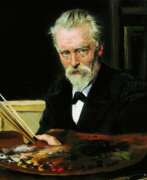

Vladimir Yegorovich Makovsky (Russian: Владимир Егорович Маковский), a distinguished Russian artist born in 1846 in Moscow, was celebrated for his genre paintings that vividly depicted everyday life with a blend of humor and social critique. His father, Yegor Ivanovich Makovsky, co-founded the Moscow School of Painting, Sculpture, and Architecture, where Vladimir later studied and taught, shaping the future of Russian art alongside his artistic family.
Makovsky's work often showcased small-town scenes and common folk, creating narratives that were both endearing and pointedly critical of societal injustices. Noteworthy pieces like "The Grape-juice Seller," "Fruit-Preserving," and "The Congratulator" highlight his skill in capturing the nuances of human expressions and interactions.
Throughout his career, Makovsky remained a pivotal member of the Peredvizhniki (Wanderers), a group dedicated to portraying real-life issues through art. His later works, such as "The Peddler" and "January 9, 1905, on Vasilyev Island," reflect his continued commitment to social themes, depicting historical events with deep empathy for the oppressed.
For art enthusiasts and collectors, Makovsky's works are pivotal in understanding the evolution of Russian realism. His paintings are held in high esteem and are featured in major museums around the world. To stay updated on exhibitions and sales related to Vladimir Yegorovich Makovsky, sign up for our newsletter, focusing exclusively on significant updates from the art world.


Kazimir Severinovich Malevich (Russian: Казимир Северинович Малевич) was a pioneering Russian artist, known for his profound influence on the development of abstract art in the 20th century. His nationality and specializations in painting, art theory, and teaching have cemented his place as a pivotal figure in the avant-garde movement, particularly for his role in founding the Suprematism movement. This movement, characterized by its focus on basic geometric shapes and a limited color palette, aimed to convey the supremacy of pure artistic feeling over the depiction of objects.
Malevich's art and theories have had a lasting impact on the course of modern art, challenging traditional perceptions of form and composition. His most famous work, "Black Square," epitomizes the essence of Suprematism. It represents a radical break from past art forms and a move towards abstraction, where the emotional and spiritual dimensions of art are prioritized. This piece, along with others like "White on White," has been exhibited in prestigious museums and galleries worldwide, showcasing Malevich's enduring legacy.
For collectors and experts in art and antiques, Malevich's works are not just paintings but are significant historical artifacts that embody a transformative period in art history. His contributions extend beyond his canvases, influencing sculpture, culture, and the broader artist school. His innovative approach to art has paved the way for future generations of artists, making his works highly sought after in the art and antique collecting community.
For those interested in the avant-garde movement and the evolution of abstract art, staying informed about Kazimir Malevich's contributions is essential. We invite you to sign up for updates related to Malevich, including notifications on new product sales and auction events. This subscription will keep you at the forefront of the latest discoveries and opportunities to acquire pieces connected to this revolutionary artist.
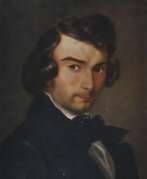

Apollon Nikolaevich Mokritsky (Russian: Аполлон Николаевич Мокрицкий) was a Ukrainian-Russian painter and art educator, known for his contributions to the 19th-century art scene. Born in 1810 in Pyryatyn, Ukraine, Mokritsky became an influential figure in Russian academic art, specializing in portrait and historical painting.
Mokritsky's work is celebrated for its detailed realism and emotional depth. His portraits often capture the essence of his subjects, showcasing his skill in rendering lifelike expressions and intricate details. One of his most notable works is the portrait of the renowned Russian poet, Taras Shevchenko, which exemplifies his ability to combine technical precision with profound sensitivity.
In addition to his painting, Mokritsky played a significant role as an educator. He taught at the Moscow School of Painting, Sculpture and Architecture, where he mentored many young artists who would go on to shape Russian art. His influence extended beyond his own works, helping to cultivate a new generation of artists.
Today, Mokritsky's paintings can be found in various museums and galleries, including the Tretyakov Gallery in Moscow. His contributions to art and education continue to be recognized and celebrated by art collectors and historians alike.
Sign up for updates to learn more about new product sales and auction events related to Apollon Nikolaevich Mokritsky.
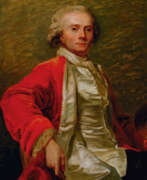

Jean-Laurent Mosnier was a French painter and miniaturist, renowned for his detailed and polished portraitures during the Ancien Régime. Born in Paris in 1743, Mosnier quickly ascended to become a court painter, notably serving Marie Antoinette. His mastery in miniature painting earned him significant acclaim, leading to a prosperous career across various European cities, including London, Hamburg, and St. Petersburg, after fleeing France due to the Revolution.
Mosnier's works are recognized for their exquisite attention to texture and fabric, skills likely honed during his early training at the Académie de Saint-Luc. He became a member of the Académie Royale in 1788, where his works, such as portraits of prominent academicians, solidified his reputation. His career spanned various shifts in his geographical and political contexts, adapting his artistic style to suit the tastes of his diverse clientele, including various European aristocrats and members of the Russian imperial family.
Several of Mosnier's significant works are housed in prestigious museums, including the Louvre and The Metropolitan Museum of Art, ensuring his legacy within the annals of European art history. For art collectors and enthusiasts interested in the rich history and exquisite craftsmanship of Jean-Laurent Mosnier's works, keeping updated on exhibitions and sales is invaluable. Sign up for updates on new product sales and auction events related to Jean-Laurent Mosnier to enhance your collection and appreciation of this distinguished artist.


Sergius Pauser, an Austrian painter, gained international recognition in the 1930s, receiving prestigious awards such as the Carnegie Exhibition Prize in Pittsburgh. After studying architecture, he switched to painting and was influenced by Max Beckmann, Otto Dix, and Karl Hofer. However, his career was halted by the Nazi regime. Adolf Hitler personally tore down Pauser's paintings, deeming them degenerate art. Pauser was banned from exhibiting and labeled politically unreliable. He ended up in a concentration camp but was later rehabilitated and reinstated as a teacher at the Academy of Fine Arts in Vienna. Despite controversy, he painted the official picture commemorating Austria's sovereignty.
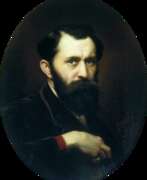

Vasily Grigorevich Perov (Russian: Василий Григорьевич Перов) was a celebrated Russian artist, renowned for his profound contributions to the world of painting. His body of work, characterized by its keen observation and poignant reflection on social issues, established him as a pivotal figure in the realm of 19th-century Russian culture. Perov's specialization in genre painting, alongside his ventures into portraiture and religious themes, showcased not only his versatility but also his deep empathy for the human condition.
Perov's artistry is distinguished by its vivid realism and emotional depth, qualities that marked a departure from the idealized narratives prevalent in the art of his time. His paintings often depicted the stark realities of everyday life, serving as a voice for the marginalized and overlooked sectors of society. This commitment to realism, combined with a masterful command of light and shadow, imbued his works with a powerful sense of immediacy and relevance.
Among his most notable works are "The Last Tavern at the City Gates," "The Arrival of a Governess in a Merchant's House," and "Troika. Apprentices Fetch Water." These paintings, along with others, can be found in prestigious museums and galleries, reflecting Perov's enduring legacy in the pantheon of Russian art. His ability to capture the essence of his subjects with both compassion and critical insight has left an indelible mark on the culture of art and painting.
For collectors and experts in art and antiques, the exploration of Vasily Perov's oeuvre offers a unique window into the socio-cultural landscape of 19th-century Russia. His works not only provide aesthetic pleasure but also invite reflection on the universal themes of human dignity, injustice, and the complexity of social dynamics. To stay informed about new product sales and auction events related to Vasily Grigorevich Perov, sign up for updates. This subscription is a gateway to the rich history and continuing relevance of Perov's artistry, offering exclusive insights into opportunities to own a piece of this illustrious legacy.
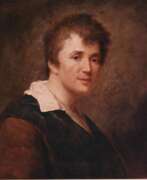

Stepan Semyonovich Shchukin (Russian: Степан Семёнович Щукин) was a distinguished Russian painter, celebrated for his refined portrait and watercolor artworks. Born in Moscow in 1754, Shchukin's artistic journey began under adverse circumstances, orphaned and admitted to the Orphan House in Moscow where he initially received his education.
Shchukin’s talent led him to the Imperial Academy of Arts, under the guidance of Dmitry Levitzky, one of the era's most esteemed Russian painters. His academic and artistic prowess earned him a scholarship to study further in Paris at the prestigious Académie de Peinture et de Sculpture, where he honed his skills with masters like Alexandre Roslin. Returning to Russia, Shchukin left a significant mark on the Russian art scene as a teacher at the Imperial Academy, influencing the next generation of artists including notable names like Alexander Varnek and Vasily Tropinin.
Among his notable works, Shchukin's portraits of eminent personalities like Emperor Paul I stand out. These portraits are not only masterpieces of art but also vital historical documents that capture the essence of an era. Shchukin's contributions to Russian art were profound, as he was integral in nurturing and shaping the aesthetic values of his time.
For collectors and experts in art and antiques, Shchukin's works represent a pivotal chapter in the evolution of Russian portraiture. His paintings, many of which are housed in prestigious galleries like the Russian Museum, continue to be studied and revered for their artistic and historical significance.
For updates on exhibitions and sales of Stepan Semyonovich Shchukin’s works, sign up for our newsletter. This subscription will keep you informed about the latest auction events and opportunities to acquire pieces by this illustrious artist.
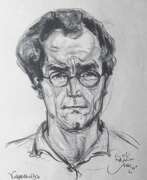

Emil Wilhelm Stumpp was a German painter, teacher, and artist known for his cartoons and drawings of well-known people in the 1930s during the Weimar Republic. He created portraits of many well known people including Bertold Brecht, Chancellor Friedrich Ebert, Thomas Mann. He was eventually commissioned to create a portrait of Adolf Hitler for his birthday in 1933. The work was not well received and the portrait, Stumpp, his paper (the General Anzeiger), and its editor were all prohibited. He left about 6,000 drawings which were all drawn from life.
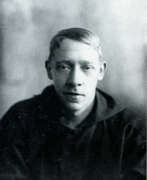

Vladimir Evgrafovich Tatlin (Russian: Владимир Евграфович Татлин) was a pioneering Russian and Soviet avant-garde artist, architect, and designer, celebrated for his innovative contributions to modern art, sculpture, and architecture. Born in Moscow, Tatlin's work transcended traditional boundaries, blending art with technology and ideology in a way that was revolutionary for his time. His dedication to merging functional design with artistic vision marked him as a key figure in the Constructivist movement, which sought to apply art to practical and social purposes.
Tatlin is best known for his ambitious but never-realized project, the Monument to the Third International, commonly referred to as Tatlin's Tower. This monumental structure, intended to serve as the headquarters for the Comintern in Petrograd, symbolized the utopian aspirations of the Soviet Union in the early 1920s. The tower's design, featuring a spiraling iron frame reaching 400 meters in height, embodied the avant-garde's commitment to innovation and the belief in art's power to shape a new societal order. Though it remained unbuilt, the tower's visionary design continues to influence architects and artists worldwide.
Beyond Tatlin's Tower, his contributions to the world of art include significant works in painting and sculpture. His approach to material and form, particularly his counter-reliefs, challenged traditional artistic conventions and opened new avenues for exploration in modern art. Tatlin's legacy extends to educational realms as well, where his tenure at the Moscow Vkhutemas (the Higher Art and Technical Studios) helped shape a generation of artists and designers. His works are preserved in major museums and galleries around the globe, serving as a testament to his enduring influence on culture and art.
For collectors and experts in art and antiques, Vladimir Tatlin's oeuvre represents a pivotal moment in the evolution of modernist expression. His innovative spirit and radical designs continue to inspire and provoke. If you wish to stay informed about new discoveries, sales, and auction events related to Vladimir Evgrafovich Tatlin, we invite you to sign up for our updates. This subscription is an excellent opportunity for enthusiasts and collectors to stay ahead in the dynamic world of art and antiques.
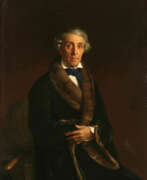

Fyodor Petrovich Tolstoy (Russian: Фёдор Петрович Толстой) was a Russian sculptor, painter, and medallist, renowned for his contributions to Russian classicism and romanticism. Born in Saint Petersburg in 1783, he became a prominent figure in the Russian art world. As a vice-president of the Imperial Academy of Arts, Tolstoy produced significant works, including medallions commemorating the Patriotic War of 1812.
Tolstoy's artistic style is characterized by its meticulous detail and classical influence. His works, such as the intricate medallions and bas-reliefs, often depict historical and allegorical scenes. These pieces are celebrated for their technical precision and emotional depth, embodying the spirit of the era.
Many of Tolstoy's creations are housed in prestigious collections, including the State Hermitage Museum and the State Tretyakov Gallery. His legacy continues to inspire and influence Russian art and culture, making him a significant figure in the history of Russian fine arts.
Subscribe for updates on new product sales and auction events related to Fyodor Petrovich Tolstoy. Stay informed about the latest opportunities to acquire pieces of his artistic legacy.
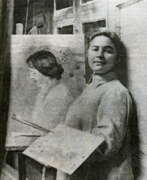

Nadezhda Savelyevna Voitinskaya-Levidova (Russian: Надежда Савельевна Войтинская-Левидова) was a multifaceted Russian artist, writer, and translator, whose life spanned from 1886 to 1965. Born into a family with a strong academic background in St. Petersburg, she carved a unique path for herself in the arts and literature. Voitinskaya-Levidova was not only known for her artistic talents but also for her resilience and adaptability through challenging times, including her wrongful arrest in 1938 and survival during the siege of Leningrad in World War II.
Her journey into the arts began with painting lessons in private studios in St. Petersburg, followed by studies in painting and lithography in Paris. Voitinskaya-Levidova's return to Petersburg marked the beginning of a prolific period where she became closely associated with the "World of Art" artists. She made significant contributions through a series of lithographic portraits of famous writers of her time in 1909, demonstrating her skill and versatility in graphic arts. Her academic achievements included graduating from the Petrograd Institute of Art History in 1924, after which she dedicated herself to teaching and translating, enriching the cultural landscape with her translations of works by European authors and her own literary works.
The legacy of Nadezhda Savelyevna Voitinskaya-Levidova is preserved in the archives of Russia's National Library and her artworks, many of which are housed in prestigious collections such as the State Russian Museum, the Tretyakov Gallery, and the Pushkin Museum of Fine Arts. Her life and work stand as a testament to her enduring spirit and significant contributions to Russian art and literature.
For collectors and experts in art and antiques, the story of Nadezhda Savelyevna Voitinskaya-Levidova is a compelling narrative of creativity, resilience, and the power of cultural expression. Her contributions to art and literature continue to inspire and resonate with audiences, underscoring the importance of preserving and celebrating her legacy.
To stay updated on exhibitions and sales related to Nadezhda Savelyevna Voitinskaya-Levidova's work, consider signing up for updates. This subscription ensures you're informed about new product sales and auction events specifically related to her oeuvre, connecting you directly with the rich history and enduring impact of her contributions to art and culture.
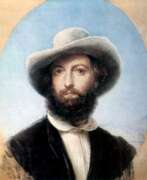

Otto Friedrich Theodor Möller (Russian: Фёдор Антонович Моллер), a Russian academic painter of Baltic-German descent, was renowned for his detailed and expressive portraits, figure paintings, and genre scenes. Born in 1812 in Kronstadt, Saint Petersburg, Möller was deeply influenced by his mentor, Karl Briullov, at the Imperial Academy of Fine Arts. His journey as an artist was marked by a successful tenure in Italy, where he embraced the vibrant local culture and further honed his skills, particularly in portraying everyday Italian life and historical narratives .
Möller's artworks are celebrated for their clarity of composition and expressive color palette, traits he mastered under Briullov's guidance. His notable works, like the portrait of Nikolai Gogol, are admired for their lifelike representation and emotional depth. These paintings not only showcase his technical skill but also his ability to capture the subtle nuances of his subjects' personalities.
Möller's contributions to Russian art extend beyond his paintings. He was a professor and a significant figure at the Imperial Society for the Encouragement of the Arts, dedicating much of his later years to teaching and supporting fellow artists. His works are held in high esteem and continue to be featured in major Russian museums, including the Tretyakov Gallery and the Russian Museum.
For collectors and enthusiasts wishing to stay updated on exhibitions and auction events featuring Otto Friedrich Theodor Möller's works, signing up for newsletters and alerts from relevant art institutions can be highly beneficial. This ensures that you remain informed about opportunities to view or purchase his esteemed works.


Konstantin Fyodorovich Yuon (Russian: Константи́н Фёдорович Юо́н) was a distinguished Russian artist and painter, celebrated for his multifaceted contributions to the world of art. Born in Moscow, Yuon's work spans painting, stage design, and teaching, making significant impacts across these fields. His artistry is renowned for blending traditional Russian motifs with innovative techniques, illustrating the rich tapestry of Russian culture and history.
Yuon's masterpieces are characterized by their vibrant use of color and light, capturing the essence of Russian landscapes and urban scenes with a unique lyrical quality. His notable works, such as "New Planet" and "The March Sun," showcase his ability to transcend the ordinary, offering viewers a glimpse into the ethereal beauty of everyday life. These pieces not only highlight his technical prowess but also his profound understanding of the emotional and cultural significance of his subjects.
Throughout his career, Yuon's influence extended beyond the canvas, as he nurtured the next generation of artists through his teaching. His dedication to the arts was recognized with prestigious awards, affirming his status as a pillar of the Russian art community. Today, his works are preserved in major museums and galleries, serving as a testament to his enduring legacy in the fields of painting and cultural heritage.
For collectors and experts in art and antiques, the legacy of Konstantin Fyodorovich Yuon offers a fascinating exploration into the evolution of Russian art. His works not only represent significant artistic achievements but also embody the cultural and historical narratives of their time. To stay informed on new product sales and auction events featuring Yuon's work, we invite you to sign up for updates. This subscription will ensure you're always in the loop on opportunities to own a piece of Russian art history.


